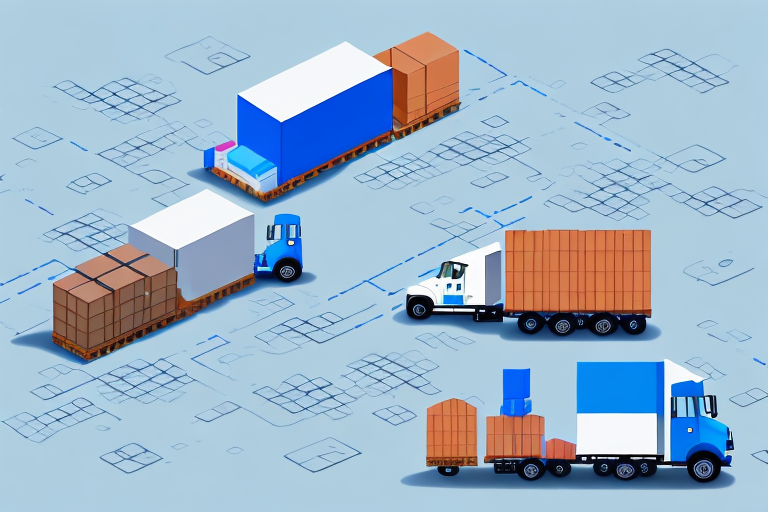Live Unloading: Optimizing Your Supply Chain for Maximum Efficiency
In today's fast-paced business world, optimizing your supply chain is crucial for success. One strategy that has gained popularity in recent years is live unloading. In this article, we will explore the concept of live unloading, its benefits, factors to consider when implementing it in your supply chain, and best practices for successful implementation. We will also look at the role of technology in optimizing your supply chain for live unloading, common challenges you may face, and real-world examples of successful implementations. Finally, we will discuss how to measure the success of your live unloading implementation.
Understanding the Concept of Live Unloading
Live unloading refers to the process of unloading goods from a truck or trailer while it is still in motion, rather than requiring it to come to a complete stop. This can be done using various technologies, such as rollerbeds or conveyors, that allow the goods to be unloaded quickly and efficiently. The goal of live unloading is to minimize loading and unloading times and increase overall efficiency in the supply chain.
Live unloading is particularly useful for time-sensitive goods, such as perishable items or those with a short shelf life. By reducing the time it takes to unload these goods, they can be delivered to their destination faster, ensuring their freshness and quality. Additionally, live unloading can also improve safety by reducing the risk of accidents that can occur during traditional loading and unloading processes.
The Benefits of Implementing Live Unloading in Your Supply Chain
- Reduced Loading and Unloading Times: With traditional methods, trucks may have to wait in line to be unloaded, resulting in long wait times and increased costs. Live unloading eliminates these wait times, allowing for faster turnaround times and increased productivity.
- Decreased Risk of Damage to Goods: When a truck comes to a complete stop, there's a higher risk of shifting and movement of the goods, which can lead to damage. Live unloading provides a smoother and more controlled unloading process, reducing the risk of damage and potential loss of revenue due to damaged goods.
- Enhanced Worker Safety: Traditional unloading methods often require workers to climb onto the truck and manually unload the goods, which can be dangerous and lead to injuries. Live unloading removes the need for workers to climb onto the truck, thereby reducing the risk of accidents and injuries. This not only benefits workers but also minimizes liability for the company.
Factors to Consider When Implementing Live Unloading in Your Supply Chain
Before implementing live unloading, several key factors must be considered to ensure a successful integration into your supply chain:
- Type of Goods: Assess whether your goods are suitable for live unloading. Fragile or highly perishable items may require more delicate handling, which might not be compatible with live unloading techniques.
- Technology Availability: Ensure that the necessary technology, such as rollerbeds or conveyors, is available and suitable for your specific unloading requirements.
- Facility Layout: Your facility must have adequate space and the right layout to accommodate live unloading equipment and processes.
- Safety Considerations: Evaluate the safety implications, including potential risks to workers and equipment, and ensure that proper safety protocols are in place.
- Cost Implications: Consider the costs associated with purchasing and installing live unloading equipment, as well as training and staffing requirements. Weigh these against the potential benefits like increased efficiency and reduced labor costs.
- Supply Chain Impact: Analyze how live unloading will affect your overall supply chain operations. Determine if it will disrupt existing processes or require changes to workflows and systems.
How to Prepare Your Supply Chain for Live Unloading
Implementing live unloading requires meticulous planning and preparation. Here are the steps to prepare your supply chain:
- Identify Optimal Locations: Determine the best locations within your facility for live unloading, considering factors such as space, safety, and accessibility.
- Invest in Technology: Procure the necessary live unloading technology and ensure it's installed correctly to facilitate a smooth unloading process.
- Train Your Workforce: Provide comprehensive training to workers who will be handling the live unloading process to ensure they are proficient with the new equipment and procedures.
- Communicate with Stakeholders: Clearly communicate your live unloading plans with carriers, suppliers, and other stakeholders to ensure a seamless transition and avoid potential delays.
- Adjust Inventory Management: Implement systems to quickly and accurately record the receipt of goods unloaded via live unloading, ensuring that inventory levels remain up-to-date and discrepancies are promptly identified.
- Continuous Improvement: Regularly review and evaluate your live unloading processes to identify areas for improvement. Utilize data analytics to assess loading and unloading times, identify bottlenecks, and implement new technologies or processes as needed.
Best Practices for Successful Live Unloading
To ensure the successful implementation of live unloading, consider the following best practices:
- Regular Training: Conduct ongoing training sessions for employees to keep them updated on the latest technologies and safety protocols related to live unloading.
- Effective Communication: Establish clear communication channels with all stakeholders, including carriers, suppliers, and customers, to ensure everyone is aligned and any issues are promptly addressed.
- Equipment Maintenance: Perform regular maintenance and inspections of all live unloading equipment to prevent breakdowns and ensure optimal performance.
- Environmental Considerations: Choose energy-efficient equipment and implement sustainable practices such as recycling and reducing packaging to minimize the environmental impact of your supply chain operations.
- Data-Driven Decisions: Utilize data and analytics to monitor the performance of live unloading processes and make informed decisions for continuous improvement.
The Role of Technology in Optimizing Your Supply Chain for Live Unloading
Technology plays a pivotal role in optimizing your supply chain for live unloading. Key technologies include:
- Advanced Tracking and Monitoring Systems: These systems provide real-time visibility into the status of shipments, enabling better coordination and efficiency.
- Automation Technology: Automation speeds up the unloading process and reduces the reliance on manual labor, enhancing overall efficiency.
- Warehouse Management Systems (WMS): WMS streamline the live unloading process by providing real-time inventory data and ensuring that the right goods are unloaded at the right time.
- Predictive Analytics: By analyzing historical data and current trends, predictive analytics can identify potential issues before they occur, allowing for proactive measures to prevent delays or disruptions.
- Cloud-Based Platforms: These platforms facilitate real-time communication and collaboration across the entire supply chain, enhancing coordination between warehouses, carriers, and customers.
Common Challenges and How to Overcome Them When Implementing Live Unloading
Implementing live unloading can present several challenges. Here’s how to overcome them:
- Investment in New Technology: The initial cost of live unloading technology can be high. To mitigate this, conduct a thorough cost-benefit analysis to ensure the long-term gains justify the upfront investment.
- Worker Training: Ensuring that workers are adequately trained to use new technologies is crucial. Implement comprehensive training programs and provide ongoing support to enhance proficiency.
- Safety Protocols: Adhering to safety protocols is essential to prevent accidents. Regularly review and update safety procedures, and ensure that all employees are aware of and follow them diligently.
- Stakeholder Management: Managing multiple stakeholders can be complex. Foster strong relationships through regular communication and collaboration to ensure everyone is aligned with the live unloading initiatives.
- Infrastructure Modifications: Adapting existing infrastructure to accommodate live unloading equipment can be costly and time-consuming. Plan infrastructure changes meticulously to minimize disruptions and ensure a smooth implementation process.
Case Studies: Real-World Examples of Successful Live Unloading Implementations
Several companies have successfully implemented live unloading, yielding significant efficiency gains:
- Major Retailer: A leading retailer integrated live unloading in its distribution centers, resulting in reduced loading and unloading times and enhanced supply chain efficiency.
- Manufacturing Company: A manufacturer adopted live unloading in its production line, achieving faster turnaround times and increased productivity.
- Logistics Company: By implementing live unloading in its trucking fleet, a logistics firm reduced time spent at loading docks, expedited delivery times, and increased customer satisfaction. Additionally, optimized routes led to reduced fuel consumption and cost savings.
Measuring the Success of Your Live Unloading Implementation
To ensure that your live unloading implementation is effective, it's essential to measure its success using key metrics:
- Loading and Unloading Times: Track the time taken to load and unload goods to assess improvements in efficiency.
- Goods Processed: Monitor the volume of goods processed through live unloading to evaluate productivity gains.
- Supply Chain Efficiency: Analyze overall supply chain performance metrics to determine the impact of live unloading on your operations.
- Cost Savings: Evaluate the cost reductions achieved through decreased labor costs and minimized wait times.
- Customer Satisfaction: Gather feedback from customers to assess improvements in delivery times and product quality.
Regular monitoring and analysis of these metrics will help identify areas for improvement and ensure that your supply chain operates at maximum efficiency.
Conclusion
Live unloading is a powerful strategy for optimizing your supply chain and enhancing overall efficiency. By understanding the concept of live unloading, recognizing its benefits, and carefully considering the factors involved in its implementation, you can develop a successful integration plan. Adhering to best practices, such as regular training and effective communication, will facilitate a smooth transition. Additionally, leveraging technology can further optimize your supply chain operations. By continually measuring the success of your live unloading implementation, you can identify areas for improvement and maintain a competitive edge in the market.




















